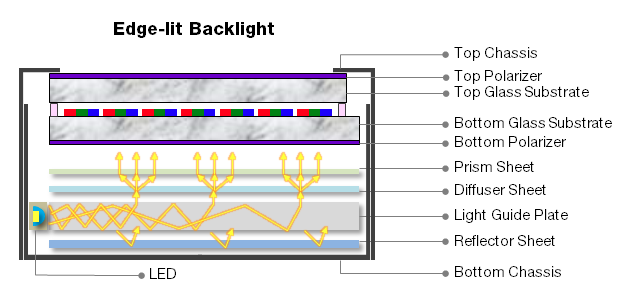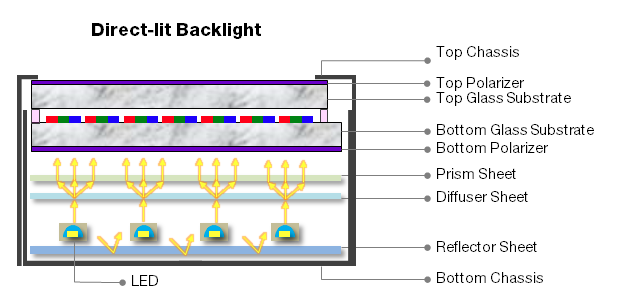What Is a Backlight?
UN backlight is a light source located behind a liquid crystal display (LCD). Since the LCD itself does not emit light, it relies on the backlight to modulate and display images. The quality of the backlight directly affects the visual performance of the liquid crystal display module (LCM).
History and Evolution of Backlights
The development of backlight technology can be traced back to World War II, when ultra-small tungsten filament lamps were used in aircraft instrument panels. This marked the early stage of backlight application. After more than half a century of continuous innovation, backlighting has become a specialized field in electronics and a hot topic for research and development.
What Is LED Backlighting?
LED backlighting uses light-emitting diodes (LEDs) as the light source. LEDs are made from thin layers of doped semiconductor materials. One layer has excess electrons, while the other has a shortage, forming positively charged holes. When current flows, electrons and holes recombine, releasing energy in the form of light.
By using different materials, LEDs can produce a range of colors including red, green, blue, cyan, orange, amber, and white. For LCD TVs, LED backlights can be either white or RGB (red, green, blue), and in some high-end displays, even six-primary-color LED backlighting is used to improve color accuracy.
Advantages of LED Backlighting
- Slim Design: Typically around 5 cm thick
- Wide Color Gamut: Up to 105% NTSC
- High Contrast: Black light flux as low as 0.05 lumens, enabling contrast ratios up to 10,000:1
- Long Lifespan: Up to 100,000 hours
- Risparmio energetico: Especially beneficial for portable devices like laptops
Classificazione della retroilluminazione a LED
LED backlight systems can be categorized based on optical design and LED chip configuration.
By Optical Structure
1.Edge-lit LED Backlighting

Light sources are placed along the edges of a piastra guida alla luce, making it possible to produce ultra-thin displays. Designs can vary from single-sided to dual- or triple-sided depending on application.
2.Bottom-lit (Direct-lit) LED Backlighting

LEDs are arranged directly behind the LCD panel. Normally dont use light guide plate,but foglio di diffusore .This provides more uniform brightness and is often used in high-end or large-sized displays.
3.Hybrid (Tiled) LED Backlighting
Combines edge-lit and direct-lit features to optimize performance and energy efficiency.
By LED Type
- Monochrome LEDs
- Dual-color LEDs
- Tri-color (RGB) LEDs
Advanced setups can also use filterless LCD panels, switching different monochromatic LEDs in sequence to achieve full-color displays.
Purpose and Benefits of LED Backlights
LED backlighting brings significant advantages to modern display technology:
1. Enhanced Image Quality
LEDs reduce motion blur and deliver vivid, accurate colors, ideal for fast-moving images such as sports or action content.
2. Reduced Manufacturing Cost
By using sequential color mixing, LED systems can replace traditional color filters, which make up about 30% of the cost of an LCD panel.
3. Thinner and Lighter Displays
Edge-lit LEDs help reduce overall screen thickness, making devices more portable and stylish.
4. Extended Battery Life
Especially in laptops, LED backlighting can increase battery efficiency by over 40%.
 Soluzioni di retroilluminazione personalizzate & Fornitore di fogli ottici – Rnoda Tech
Soluzioni di retroilluminazione personalizzate & Fornitore di fogli ottici – Rnoda Tech

